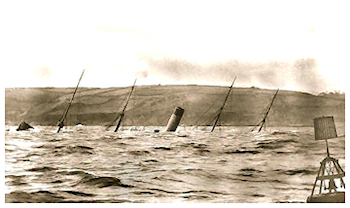The Mohegan Shipwreck
Manacle Reef Cornwall
In 1898 the "Mohegan" went down.
This disaster resulting in the loss of 107 lives, and the total destruction of the vessel was one of the most appalling and, at the same time one of the most inexplicable wrecks, which ever happened on the Cornish Coast.

She struck as the last glimmer of daylight faded at a quarter to 7 on the 14th day of October, and in less than 20 minutes she was under water, with only her masts, funnel, and davits above to mark her whereabouts. What brought her in such a perilous position will ever remain a mystery. After passing the Eddystone the Captain who wishes to clear the Manacles and the Lizard usually steers west-south-west but Cap Griffiths the Commodore of the Atlantic Transport line (by some error of compasses or judgment) drove his ship in a West by North direction right on to the Minstrel rock, in the heart of the Manacles.
An ominous, grating sound told the passengers and crew what had happened, and there was a general rush from dinner tables, cabins, and engine rooms, to the upper deck. The situation was awful, and was rendered trebly so by the sudden extinction of the electric lights. Darkness above, a swell on the sea around, a mournful tolling of the warning bell - the rising of water in the ship, all contributed to swell a cause for panic. But of panic there was none, and clear, encouraging and commanding was Chief Officer Couch's voice as he gave orders for the women and children to be saved first. The Captain too was active and cool, but the moments were passing and each one brought the "Mohegan's" doom nearer.
She had been struck on her starboard side forward, her fore part was becoming engulfed, her ship's boats were launched with difficulty and one containing many passengers upturned as she touched the water. Much remained to be done when with a mighty plunge the vessel went down and was locked on the reef, never to rise again.
Then came the time of anguish and the shrieks which arose from masts, boats and broken spars will ever be associated in the minds of the hearers on shore with that terrible night. By that time however the Life Boat from Porthoustock (under the guidance of James Hill, Coxswain) had been launched, and the Rocket Apparatus (in charge of Mr. Jeft'ers) also was on its way to Manacle Point.
All were eager to help, and had there been light instead of darkness more lives might have been saved, but the position of the vessel was a matter of conjecture, and it was most difficult to decide which course to take. Meanwhile the Life-boat threaded her way among the deadly rocks continually sending out her signals, at length cries of distress guided her to the ship's boat which was three parts full of water, and from this boat she rescued twenty seven, and picked up from the water Miss Noble. These were landed at Porthoustock about eleven, and were conducted at once to the cottages where fires, beds, and food awaited them. While they were being tended the Life Boat was once more piloting her way on the dark heaving waters. It was 2 o'clock in the morning when it returned, and the saved were in a worse condition than those in the first boat, having been 7 hours struggling for very life.
The next few days no pen can adequately describe, The Vicarage and Church were places of mourning and joy. Bereaved friends wept while relatives of the rescued ones rejoiced.
It was a time for cabling, interviewing, identifying, a time of inquiries and inquests of sheltering and hospitality. From the Squire at Lanarth to the humblest cottager, all opened their doors to the stranger, and did what they could to those who needed help.
Unhappily 107 were past human ministration and 48 of these were laid in the Church, at one time. Some of them destined to be carried across the Atlantic. For the others one vast grave, and a few smaller ones were being prepared in the old Churchyard.
Sunday intervened between the wreck and the burial, and the Services conducted by Canon Diggens took place in the presence of the dead and the living.
The following Wednesday, the great funeral took place. The Service was read by the Vicar assisted by the Rev Dr. Eajar of Manaccan and the Rev.F.R. Sell, The committal sentences were said as each separate coffin was being lowered into the big grave. Loving hands had made wreaths for every coffin (with flowers supplied from Lanarth), Life Boat men and survivors were the bearers. The following Sunday Memorial Services were conducted by Archdeacon Cornish (afterwards Bishop of St Germans) and Canon Diggens.
A beautiful stained glass window now occupies a place above the altar. It was presented by the Atlantic Transport Company, and dedicated by Archdeacon Cornish, in the presence of a vast congregation, who contributed for the erection of a large Granite Cross which now marks the site of the grave on the North Side of the Church, with the simple word "Mohegan" on it.
After the wreck of the "Mohegan" the necessity for a light was strongly urged by the Vicar, both in the TIMES Newspaper and Trinity House, but no notice whatever was taken of the appeal until a larger and more important ship went ashore the following year on the same reef.
Wikipedia - SS Mohegan
This is an extract from Cannon Diggens Archive on Shipwrecks